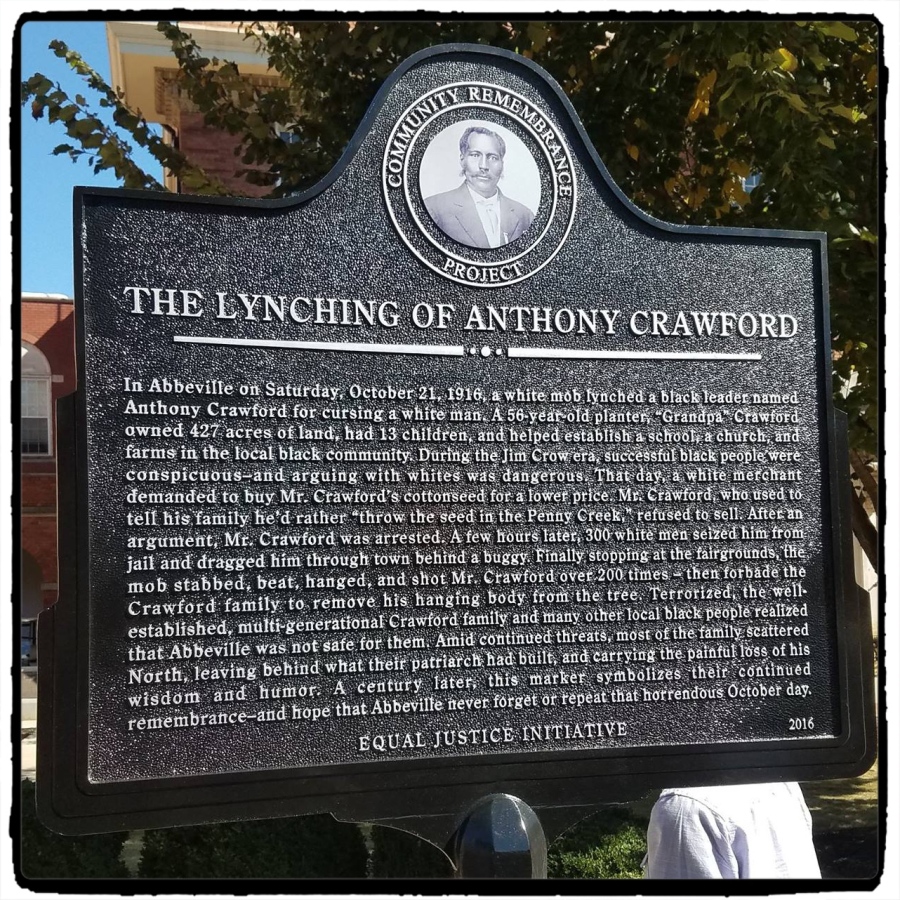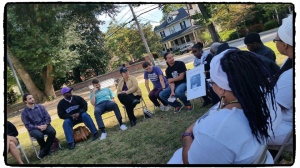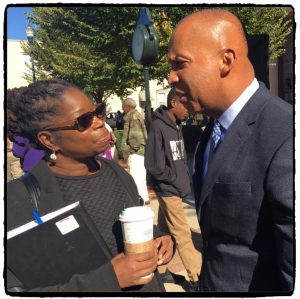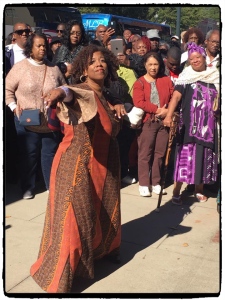—By Doria Johnson

In January of 2008, First Lady Laura Bush designated Abbeville a “Preserve America Community.” This initiative recognizes those communities that demonstrate a commitment to preserving their cultural and natural heritage. After years of denying the African American experience, Abbeville took one bold step towards that identity.

With seven weeks notice, the community and country joined the Crawford family in honoring the centennial of their banishment, and “Grandpa Crawford’s” lynching in a two-day public history event. This well-attended and publicized affair included a “Freedom School”; a lynching-site soil collection and faith-based consecration service; an unveiling of a cast-iron marker by Bryan Stevenson; and a community-wide scholarship award service. There were roughly three hundred attendees at each event.
Filmmaker Keith Beauchamp noted, “The family of wealthy Black farmer Anthony Crawford just made history again”, harkening back to their role in the apology for lynching by the United States Senate in 2005. This time, they secured funding for the permanent marker at the site of his lynching in Abbeville, South Carolina on the centennial of his death. Many folks in Evanston have a connection to Abbeville, and the 1916 brutal mob lynching of Crawford fueled a large outmigration beyond the chain from Abbeville to Evanston, to all across the United States.
We made history today. No longer can folks walk into government buildings in Abbeville without first encountering Grandpa Crawford. – Doria Johnson
The American South is littered with physical representations of the Confederacy, an increasing controversial issue, especially in light of the 2015 racial terror Charleston shootings by Dylan Roof of eight praying Black church members, and the assassination of their pastor South Carolina State Senator, Clementa Pinckney. Abbeville district AME Bishop Samuel L. Green, Sr. said “these killings are the evidence that we are experiencing a new lynching era”.
A few months earlier just up the road in North Charleston, unarmed African American Walter Scott was gunned down by white Officer Michael Slager. Despite video and strong evidence that Officer Slager hunted Scott as if her were a deer, rabbit or turkey, Scott was granted a mistrial, even though Slager can be seen planting a Taser gun on Scott, in front of other officers. Roof was recently convicted and is eligible for the death penalty; he will be sentenced January 17, 2017. From Crawford until now, racial terror is as American as apple pie.
Joining the Crawford family members were the families of Angela Davis, Malcolm X, Ida B. Wells-Barnett, Emmett Till, as well as students from Kenyon College in Ohio, national and local activists, human rights workers, historians, sociologists and faith leaders. Many people from all walks of life descended on Abbeville to bear witness to the terror and trauma of the survivors of the Crawford lynching.

On the first day of the event, Friday morning, The Septima Clark Freedom School was opened in the Jefferson Davis Park with undergraduate students from Kenyon College, teachers, activists and Crawford family members leading classes. Later at dusk, the soil collection interdenominational service included clergy from around the country, including Rev. Dr. Jim Forbes, Riverside Church; Rev. Dr. Freddy Haynes, Friendship West Baptist Church; Rev. Dr. Dale T. Irvin, World Churches, and Evanston native Dr. Iva Carruthers, General Secretary of the Samuel DeWitt Proctor Conference, who wrote the service of sacred memory.

On Saturday morning, Bryan Stevenson unveiled the marker in front of a large crowd, including many press members and filmmakers. Stevenson not only congratulated the family for their steadfastness, but he also told stories of survival and racial conflict. One story was about a woman who could not enter a Southern courthouse after being terrorized by police dogs during the Black Freedom Movement demonstrations in her childhood in the 1960’s. She had been on Edmond Pettis Bridge in Alabama when police brutally beat marchers and set dogs upon them, and the trauma of those dogs followed her entire life. In front of Stevenson, she finally mustered the courage to attend a trial of an innocent Black neighbor, and declared “We are here!”. Stevenson asked the crowd to chant ‘we are here’ over again to demonstrate to attendees, ‘the region and the nation’ that the victims of lynchings did not disappear and are still affected by the aftermath.

In the afternoon, the community gathered at the Crawford family church, 149-year old Cypress Chapel AME Church (which borders the Crawford homestead). Several local teenagers were awarded scholarships by the Equal Justice Initiative, and Crawford family members from around the country spoke about their legacies.

Local Evanston residents also participated including Second Baptist Senior Pastor Rev. Dr. Michael C.R. Nabors, District 65 teacher Pat Gregory, Museum of Science and Industry/Yoga Instructor Gail Hutchison as well as 98-year old Lois Johnson, who attended as a salute to her dear late friend, Annabelle Frazier, Crawford’s granddaughter and family culture keeper.
Today, the Crawford family has made major strides towards recognition and justice. Just a few weeks later, Abbeville, the “birthplace and deathbed of the Confederacy” elected its first Black mayor, Santana Freeman. White City Manager Dave Krumwiede, and his assistant Blake Stone, provided critical leadership, ensuring the installation’s realization and also comfort for the family. Krumwiede said it was time for ‘generational change.’ The Crawfords, and the institutional collective, has plans for other actions which should change the lives of the Abbeville community. Program partners “We Say Enough”, Samuel DeWitt Proctor Conference all contributed significant support ensuring a successful event.
Note: All photographs courtesy of Doria Johnson
For more information:
Dedication of Lynching Marker to Anthony Crawford (Equal Justice Initiative) http://eji.org/news/hundreds-d edicate-lynching-marker-anthon y-crawford-abbeville-south- carolina
The Evil of Lynching Exposed (Huffington Post) http://www.huffingtonpost.com/ entry/the-evil-of-lynching-exp osed_us_5802960ae4b0985f6d1571 f7
